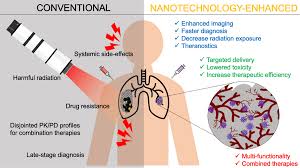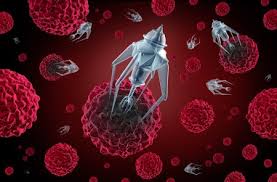
Nanotech That Can Kill Cancer Cells Without Chemo
For decades, chemotherapy has been the frontline treatment for many types of cancer. While often effective, it comes with a heavy cost—damaging healthy cells, weakening the immune system, and causing side effects like hair loss, fatigue, and nausea. But a revolutionary wave of science is changing that narrative. Enter nanotechnology—tiny, smart machines designed to find and destroy cancer cells with pinpoint accuracy, leaving healthy tissue untouched.
This isn’t sci-fi. It’s real, and it’s happening in labs and clinical trials around the world. Here’s how nanotech is quietly reshaping the future of cancer treatment—without the need for traditional chemo.
What Is Nanotechnology in Medicine?
Nanotechnology involves engineering materials and devices on a scale of billionths of a meter. That’s about 1/100,000th the width of a human hair. At this scale, materials gain new properties—becoming faster, more reactive, and able to interact with biological systems in ways larger particles can’t.
In cancer therapy, nanoparticles are being designed to:
-
Seek and bind specifically to cancer cells
-
Deliver drugs directly inside tumors
-
Trigger cell death using light, heat, or magnetic fields
-
Monitor tumors in real time through imaging
These are not just passive particles; they are often equipped with targeting molecules, imaging agents, and even logic systems that allow them to respond to their environment like tiny biological robots.
How Does Nanotech Kill Cancer Without Chemo?
1. Targeted Drug Delivery
One of the biggest limitations of traditional chemo is that it can’t distinguish between healthy and cancerous cells. Nanoparticles, however, can be engineered to recognize unique markers on cancer cells—delivering toxic agents directly to the tumor while sparing healthy tissues.
This dramatically reduces side effects and allows for higher local concentrations of treatment.
2. Photothermal and Photodynamic Therapy
Some nanoparticles absorb specific wavelengths of light and convert it into heat. When these particles accumulate in a tumor and are exposed to near-infrared light, they heat up and destroy cancer cells—a process known as photothermal therapy.
In photodynamic therapy, nanoparticles release reactive oxygen species when activated by light, killing cancer cells from within.
3. Magnetic Hyperthermia
Iron oxide nanoparticles can be directed to tumors and then activated by alternating magnetic fields, generating localized heat that damages cancerous tissue without harming surrounding areas.
4. Gene Silencing and RNA Interference
Nanotech is also being used to deliver small RNA molecules that turn off cancer-causing genes. This approach can stop tumors from growing or make them more vulnerable to other treatments—all without toxic chemicals.
Real-World Successes
While still emerging, nanotech cancer therapies are not just theoretical. Some are already showing promising results:
-
Doxil: A liposome-encapsulated form of the chemotherapy drug doxorubicin, Doxil uses nanotech to reduce toxicity and improve delivery.
-
NU-0129: A gold-based nanoparticle carrying small interfering RNA (siRNA), currently being tested to treat brain tumors by silencing a key cancer gene.
-
Smart nanoparticles developed at MIT and Stanford have shown the ability to “sniff out” tumor microenvironments and release drugs only when triggered by cancer-specific enzymes.
Dozens more are in preclinical or early clinical trials, targeting breast cancer, lung cancer, melanoma, and more.
Why This Matters
The traditional cancer treatment model—cut (surgery), burn (radiation), and poison (chemo)—is being replaced by a more intelligent, less invasive approach.
Nanotech promises to:
-
Reduce side effects
-
Improve survival rates
-
Enable early diagnosis and treatment
-
Support personalized medicine
It also opens the door to combining therapy and diagnostics into a single “theranostic” nanoparticle, capable of detecting cancer, treating it, and monitoring results—all in one.
Challenges to Overcome
Despite the excitement, there are hurdles:
-
Biocompatibility: Ensuring nanoparticles don’t trigger immune responses or accumulate in organs long-term.
-
Scalability: Producing consistent, high-quality nanoparticles on a large scale is complex.
-
Regulation: Because nanotech doesn’t fit neatly into existing drug categories, regulatory pathways are still evolving.
Still, with increased funding, advanced imaging tools, and AI-driven design, these challenges are being addressed rapidly.
The Future of Cancer Treatment
Imagine a future where:
-
A simple injection delivers billions of smart nanoparticles into your bloodstream.
-
These particles home in on cancer cells, bypassing everything else.
-
Once they reach the tumor, they release their treatment or activate with external light.
-
After doing their job, they harmlessly break down or exit the body.
That future may be closer than we think.
Nanotechnology isn’t just offering hope—it’s providing a smarter, safer, and more precise way to fight one of humanity’s deadliest diseases.
Final Thoughts
We may soon look back at chemotherapy the way we view old-school surgeries without anesthesia—crude but necessary at the time. Nanotech is giving us tools to fight cancer with elegance, intelligence, and minimal harm.
As research progresses and clinical trials expand, we’re entering a new era—where cancer cells can be targeted like threats in a digital system and neutralized with surgical precision.
And for millions around the world, that could mean hope without suffering, treatment without compromise, and healing without poison.
